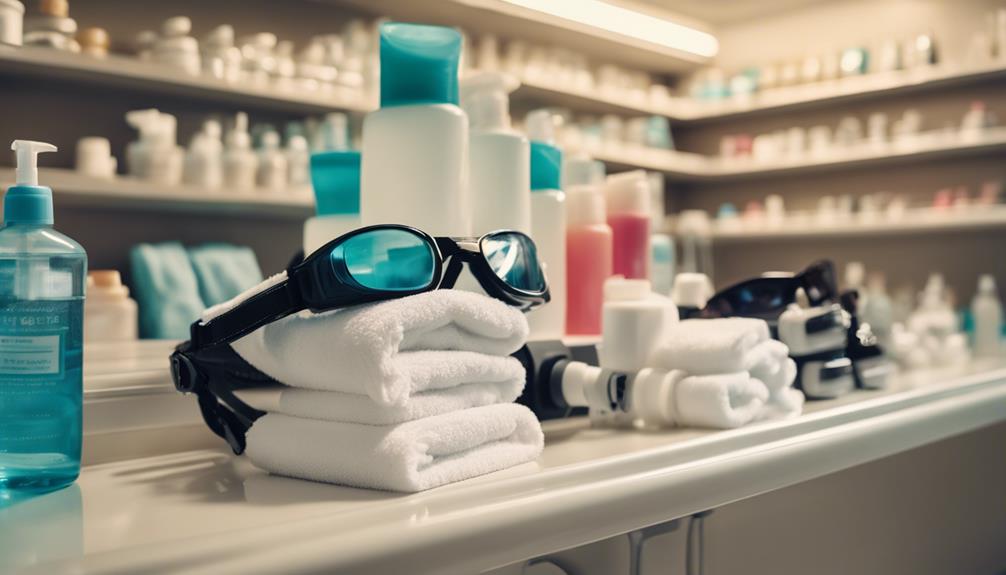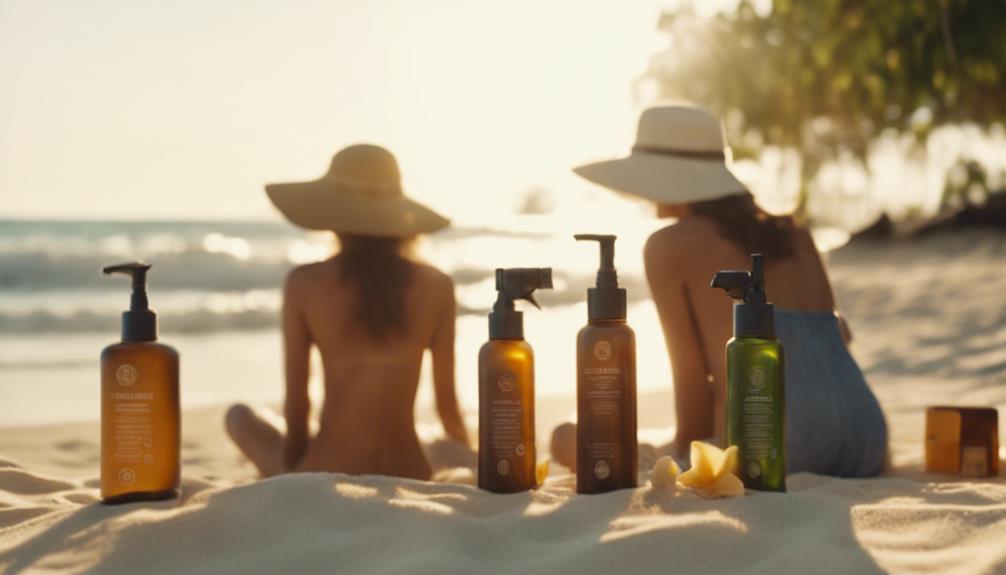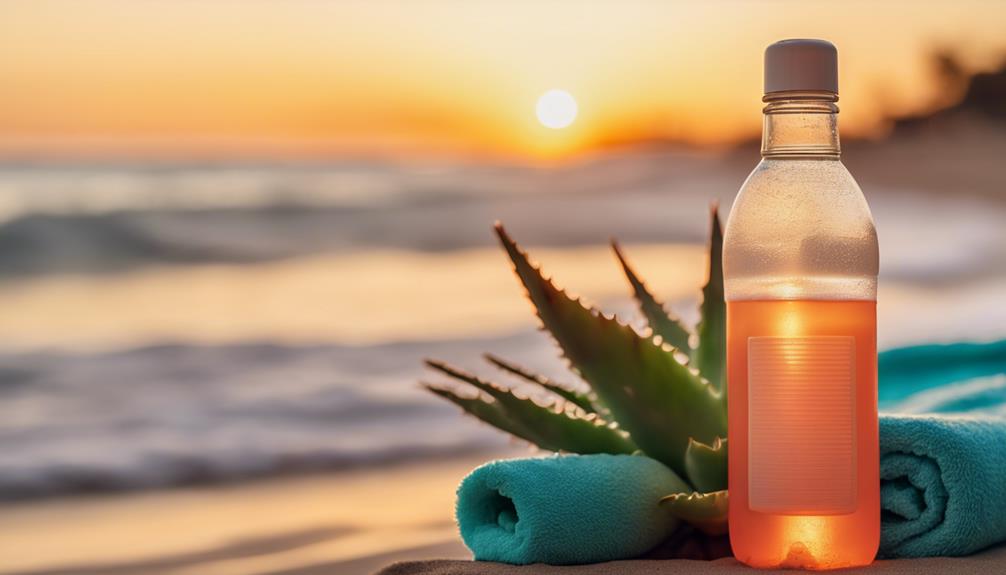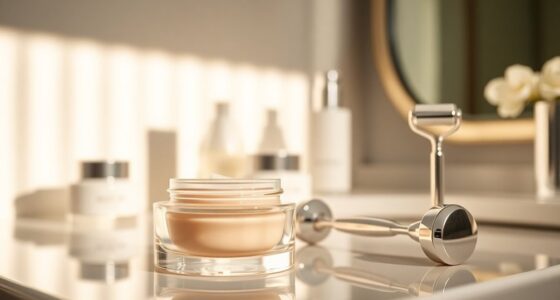For perfect tanning, start with proper hygiene. Shower and exfoliate your skin to eliminate dead cells, ensuring a smooth base. Use a gentle scrub and avoid oil-based products. Before applying your tanning product, choose one that matches your skin's undertones for the best results. Clean your tanning equipment, including beds and applicators, to avoid any contamination. When applying the product, use circular motions and a mitt or gloves to keep your hands clean. Finally, lock in moisture with a non-oil-based moisturizer post-tan. Following these tips will set you up for success, and there's more to discover about maintaining that glow.
Key Takeaways
- Sanitize tanning equipment, including beds and accessories, before use to ensure a clean and safe tanning experience.
- Use disposable gloves or a tanning mitt to prevent product staining on hands during application.
- Wipe down high-contact areas of the tanning bed with disinfectant wipes to maintain hygiene.
- Lightly dust tanning surfaces with baby powder for a smooth application and to prevent product slip.
Pre-Tan Preparation
Before you start tanning, it's important to shower and exfoliate your skin to guarantee a smooth, even application.
Use a gentle body scrub or exfoliating gloves to remove dead skin cells, ensuring your skin's clean and dry. Avoid oil-based products, as they can interfere with tanning results.
Don't forget to moisturize dry areas like your elbows, knees, and hands, applying a non-oil-based moisturizer to prevent uneven patches.
After exfoliating, finish with a cool shower to close your pores. This step is vital for best tanning results.
Selecting Tanning Products
Choosing the right tanning products is essential for achieving a natural-looking glow that complements your skin tone.
Start by selecting a bronzer that matches your skin's undertone; for fair, cool-toned skin, consider a green-based tan to achieve a balanced look. Brands like Isle of Paradise offer color-correcting options tailored to various skin types, making application easier and more effective.
If you're using tanning bed intensifier lotions, look for ingredients like tyrosine to enhance melanin production and guarantee moisture retention.
Remember to apply products evenly using techniques like the palm-to-pit method for arms.
Tanning Equipment Hygiene

Sanitizing tanning equipment is essential for guaranteeing a safe and hygienic tanning experience. Before you hop on that tanning bed, always disinfect it with a suitable spray. Wipe down high-contact areas like the headrest and handles with a clean towel or disposable wipes. This simple act helps prevent skin irritations and maintains health.
| Step | Action | Purpose |
|---|---|---|
| 1. Pre-Clean | Spray disinfectant | Remove germs |
| 2. Wipe Down | Use clean towel/disposable wipes | Guarantee thorough cleaning |
| 3. Dust Powder | Lightly dust with baby powder | Create a smooth surface |
Also, remember to use barrier creams and disposable gloves for application. These practices keep your tanning experience safe and enjoyable!
Proper Application Techniques
Applying tanning products correctly is essential for achieving an even and natural-looking tan.
Start by using a tanning mitt or disposable gloves to prevent staining your hands. Apply the product in circular motions, working from your feet upwards to avoid streaks.
Focus on tricky areas like elbows and knees, using less product there to prevent dark patches. Don't forget to blend around your wrists and ankles for a seamless finish.
For your face, use a smaller amount and blend thoroughly, avoiding the hairline.
Always follow the product instructions for drying time and reapplication, ensuring you achieve the desired depth of color without unevenness.
Post-Tan Care Routine

To maintain your tan and keep your skin healthy, hydrate immediately with a non-oil-based moisturizer after tanning. This locks in moisture and helps your tan last longer.
Apply Vaseline to your elbows and knees to prevent these areas from darkening. Be gentle when showering; avoid scrubbing your skin, as this can strip the color.
Opt for a cream-based self-tanner for touch-ups, and blend it well for an even appearance. After applying any tanning products, wash your hands thoroughly to avoid streaks and guarantee consistent color.
Tanning Safety Guidelines
When tanning, always prioritize your safety by using protective eyewear and limiting your exposure to recommended time frames.
Make sure to check the tanning bed's settings and follow salon guidelines to prevent overexposure.
Stay hydrated before and after tanning; this helps maintain skin health and can enhance your tan.
Regularly inspect your skin for any unusual changes or growths, and consult a dermatologist if you notice anything concerning.
Avoid tanning if you have recent sunburn or skin irritations, as this can worsen your condition.
Finally, remember that moderation is key—overdoing it can lead to lasting skin damage.
Exploring Alternative Tanning Options

Exploring alternative tanning options can help you achieve a sun-kissed glow without the risks associated with UV exposure.
Sunless tanning products, like self-tanning lotions, sprays, and mousses, provide a safe way to enhance your skin tone. Gradual tanning lotions allow you to build your desired shade over time, guaranteeing a natural look.
Tanning wipes offer convenience for on-the-go application, while natural oils like coconut oil can enhance your skin's radiance.
Remember to exfoliate before applying any product to guarantee an even tan. Always choose products that suit your skin type and undertone for the best results.
With these alternatives, you can enjoy a beautiful tan while prioritizing your skin's health and safety.
Frequently Asked Questions
How Often Should I Clean My Tanning Equipment?
You should clean your tanning equipment before and after each use. Regular sanitization prevents infections and maintains hygiene. A consistent cleaning routine keeps everything safe and guarantees a pleasant tanning experience for you.
Can I Tan While Having Sensitive Skin Conditions?
Imagine a delicate flower under the sun, yearning for warmth. If you have sensitive skin, it's best to consult a dermatologist first. They'll guide you on safe tanning options to protect your skin's petals.
What Should I Wear During a Tanning Session?
During a tanning session, you should wear minimal clothing to guarantee even coverage. Consider a swimsuit or light, breathable materials. Don't forget to protect sensitive areas with sunscreen, even if you're indoors.
Are There Specific Products for Tattooed Skin?
Yes, there are specific products designed for tattooed skin. Look for moisturizers with natural ingredients that hydrate and protect your tattoos, ensuring they maintain vibrancy. Avoid products with harsh chemicals that could fade your ink.
How Can I Remove a Tan if It's Too Dark?
If your tan's too dark, try exfoliating with a gentle scrub or using a tan remover. Moisturizing regularly can help fade it naturally. Remember, patience is key; the color will gradually lighten over time.
Conclusion
So, while you might think all it takes for that sun-kissed glow is a few minutes in a tanning bed or slathering on bronzer, remember that neglecting hygiene can turn your perfect tan into a patchy disaster.
Picture stepping out, glowing like a bronze goddess, only to discover you resemble an overcooked piece of chicken instead.
By following these essential tips, you'll not only look radiant but also keep your skin happy and healthy.
Shine on!









